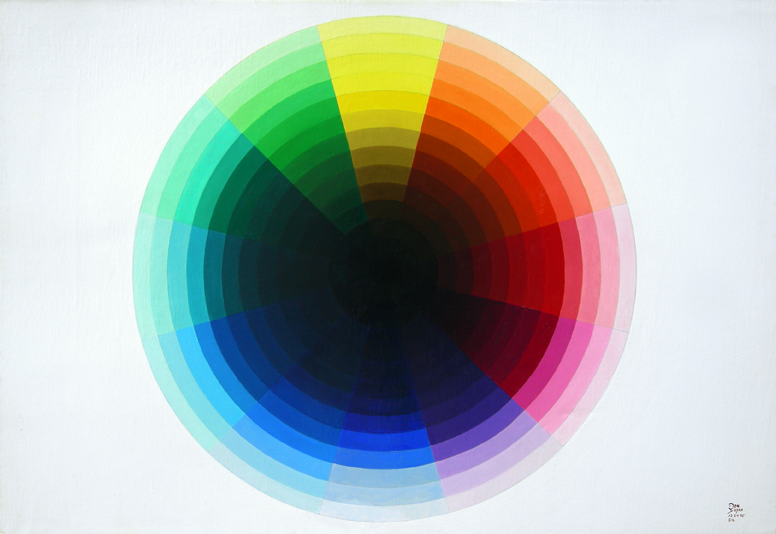

| This Real Color Wheel was painted on Maui in 1995. I number all my paintings, this one is number 816. It was painted while I was transcribing my notes that were made during the painting of each picture on location. The notes became my Real Color Wheel Color Thesis. I had noticed the green shadows became the correctly shaded color by adding transparent magenta. That's the way this color wheel was painted. Every color was darkened with it's opposite color only, no black pigment was used. Yellow takes into account that yellow darkens through brown as it gets darker, brilliant yellow is dark brown as in the titanium Rutile crystal and others. Dark brown and it's opposite color ultramarine blue made a neutral dark when they were mixed together. The neutral dark could be lightened to the gray under the clouds. Yellow-green and purple made a lighter neutral gray as did orange and cobalt blue. The other oppositions made dark neutrals.
Back then I thought my coloring book would my most important page, showing how watercolors were made using outlined patterns for each object. Well, as it turned out, the Real Color Wheel and a page I did on human proportions became the highest hit pages.

This is how the Real Color Wheel looks today, thirteen years later (2008). Still a bright white because I used acrylic paint. 2013, still bright. The biggest changes came in pigments, back then there was only one company making a transparent yellow, it matched the original transparent oil yellow that was taken out of sales in 1900 by the only company that was making it, Winsor Newton. Old Holland made a synthetic one called Indian yellow with a nickel complex and isoindolin and kept making it even though the color fell out of popularity because of no exposure. The wars did that, it took the teachers and artist that knew how to use it out of the picture. The next step was a new color theory by Church and Oswalt in 1916. That theory mixed black into a color to make it darker, that idea has prevailed until today. It also stated any color could be made with any pigments (bringing in the petro colors) that matched the dried chip color to the dry chip color of the original pigment. Not that they didn't do a good job replacing the lead colors that had survived two thousand years being the artists pigments of choice. Magenta and cyan weren't as good as the petrol chemical colors we have today either. Today we have a perfect set of transparent primary pigments that makes this color wheel work with only three colors. Another large change is from the three primary colors you were taught in school, red, yellow and blue are not he primary colors. They won't make any color and they won't mix neutral dark. The reason they were chosen in the first place is there visibility in the prism and the rainbow. That trails all the way back to Newton in 1640. This reason is how you look at the prism and rainbow. The primary colors are visiable in the prisim, it depends on the angle you view the prism. The rainbow is a different story, violet, a cool magenta is at the very bottom and a little warm magenta is at the top. My rainbow page. |
NEXT The Real Color Wheel Explained, colorwheel.htm
PREVIOUS
Dark Bkg RCW Linking Pigments explained, rcwmap.htm
